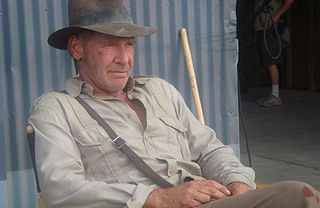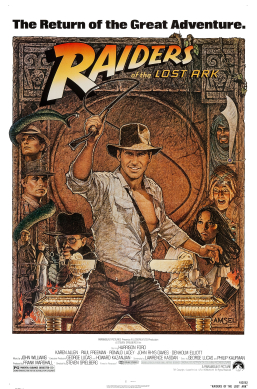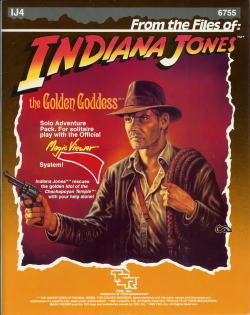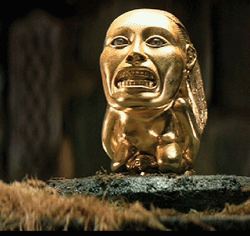
Dr. Henry Walton "Indiana" Jones, Jr. is the title character and protagonist of the Indiana Jones franchise. George Lucas created the character in homage to the action heroes of 1930s film serials. The character first appeared in the 1981 film Raiders of the Lost Ark, to be followed by Indiana Jones and the Temple of Doom in 1984, Indiana Jones and the Last Crusade in 1989, The Young Indiana Jones Chronicles from 1992 to 1996, Indiana Jones and the Kingdom of the Crystal Skull in 2008, and Indiana Jones and the Dial of Destiny in 2023. The character is also featured in novels, comics, video games, and other media. Jones is also the inspiration for several Disney theme park attractions, including Indiana Jones and the Temple of Peril, the Indiana Jones Adventure, and Epic Stunt Spectacular! attractions.

Raiders of the Lost Ark is a 1981 American action-adventure film directed by Steven Spielberg from a screenplay by Lawrence Kasdan, based on a story by George Lucas and Philip Kaufman. Set in 1936, the film stars Harrison Ford as Indiana Jones, a globetrotting archaeologist vying with Nazi German forces to recover the long-lost Ark of the Covenant which is said to make an army invincible. Teaming up with his tough former romantic interest Marion Ravenwood, Jones races to stop rival archaeologist René Belloq from guiding the Nazis to the Ark and its power.

Indiana Jones Adventure is an enhanced motion vehicle dark ride attraction based on the Indiana Jones film series, located at Disneyland and Tokyo DisneySea. Guests accompany intrepid archaeologist Dr. Indiana Jones on a turbulent quest, aboard military troop transport vehicles, through a dangerous subterranean lost temple guarded by a supernatural power.

The Chachapoyas, also called the "Warriors of the Clouds", was a culture of the Andes living in the cloud forests of the southern part of the Department of Amazonas of present-day Peru. The Inca Empire conquered their civilization shortly before the Spanish conquest in the 16th century. At the time of the arrival of the conquistadors, the Chachapoyas were one of the many nations ruled by the Incas, although their incorporation had been difficult due to their constant resistance to Inca troops.

Paul Freeman is an English actor who has appeared in theatre, television and film. In the United Kingdom, he is best known for his role in the romance TV series Yesterday's Dreams (1987) as Martin Daniels. Internationally, he is known for playing the rival archaeologist René Belloq in Raiders of the Lost Ark (1981), evil wine baron Gustav Riebmann on season 4 of the soap opera Falcon Crest (1984–85), supervillain Ivan Ooze in Mighty Morphin Power Rangers: The Movie (1995). Other credits include Morlang (2001), When I'm 64 (2004), Hot Fuzz (2007) and Hard Boiled Sweets (2012).

Marion Ravenwood is a fictional character who first appeared in the 1981 film Raiders of the Lost Ark. Played by Karen Allen, she enters the story when Indiana Jones visits her in Nepal, needing her help to locate the Ark of the Covenant with a possession originally obtained by her father, Dr. Abner Ravenwood. After 27 years of absence, the character returned in Indiana Jones and the Kingdom of the Crystal Skull (2008) and Indiana Jones and the Dial of Destiny (2023), portrayed by Allen.

Indiana Jones Epic Stunt Spectacular! is a live amusement show at Disney's Hollywood Studios at Walt Disney World in Orlando, Florida. Based on the popular and successful Indiana Jones film franchise, it includes various stunts and live reenacted scenes from the series's first film, Raiders of the Lost Ark. It is executive produced by George Lucas and directed by Jerry Rees, with stunt coordination by Glenn Randall.
Mezco Toyz is an American company that makes action figures and other collectibles based on original and licensed properties. One of the popular products is the cult hit toy line Living Dead Dolls. The more popular line is its One:12 line, which has licenses to popular brands such as Marvel, DC, and Godzilla. Other popular licensed properties include Family Guy, South Park and Hellboy. Outside of action figures and doll releases, Mezco is also known for their original block-style figures line Mez-Itz.

Sallah Mohammed Faisel el-Kahir is a fictional character played by Welsh actor John Rhys-Davies in three of the Indiana Jones films: Raiders of the Lost Ark, Indiana Jones and the Last Crusade, and Indiana Jones and the Dial of Destiny. He also appears in various comics and novels, and is featured in the Disney theme park attractions, the Indiana Jones Adventure and The Great Movie Ride.

Secret of the Incas is a 1954 American adventure film directed by Jerry Hopper and starring Charlton Heston as adventurer Harry Steele, on the trail of an ancient Incan artifact. The supporting cast features Robert Young, Nicole Maurey and Thomas Mitchell, as well as a rare film appearance by Peruvian singer Yma Sumac. Shot on location at Machu Picchu in Peru, the film is often credited as the inspiration for Raiders of the Lost Ark.
Vendyl Miller Jones was an American Noahide scholar who directed archaeological searches for biblical artifacts such as the Ark of the Covenant.
Indiana Jones is an American media franchise consisting of five films and a prequel television series, along with games, comics, and tie-in novels, that depicts the adventures of Dr. Henry Walton "Indiana" Jones, Jr., a fictional professor of archaeology.
Lego Indiana Jones is a Lego theme based on the Indiana Jones film franchise created by George Lucas, licensed from Lucasfilm. The exclusive franchise was first announced in June 2007, and followed the successful Lego Star Wars franchise, also with Lucasfilm. The first set of products were launched in 2008, based upon two of the three earlier films. Sets featuring scenes from the fourth film, Indiana Jones and the Kingdom of the Crystal Skull, were released alongside the film, later in 2008. The Temple of Doom film was not featured until 2009, in a large set which re-created the mine-cart chase using new narrow-gauge Lego train track.
The "Indiana Jones Summer of Hidden Mysteries" was an event held at Disneyland by Walt Disney Creative Entertainment during the summer months of 2008. This was a promotional tie-in with the release of Indiana Jones and the Kingdom of the Crystal Skull. The summer-long event included a new show, changes to the Jungle Cruise attraction and appearances by a live actor playing Indiana Jones.
Jane MacLaren Walsh is an anthropologist and researcher at the Smithsonian's National Museum of Natural History in Washington, D.C. She is known for her role in exposing faked pre-Columbian artifacts.

Raiders of the Lost Ark: The Adaptation is a 1989 American fan film, made as a shot-for-shot remake of the 1981 Indiana Jones adventure film Raiders of the Lost Ark. Using the original film's screenplay and score, it principally starred and was filmed, directed, and produced over a seven-year period by three Mississippi teenagers.
Since its debut in 1981, the Indiana Jones franchise has become part of American popular culture. References have been made in television series, movies, music and other material since the original film was released.

The Golden Goddess is a solo adventure published by TSR in 1985 for the action-adventure role-playing game The Adventures of Indiana Jones Role-Playing Game, itself based on the Indiana Jones movie franchise.













